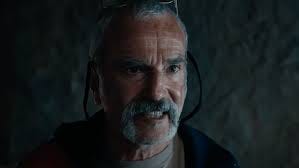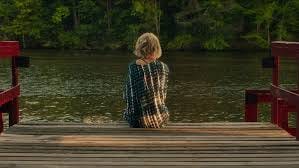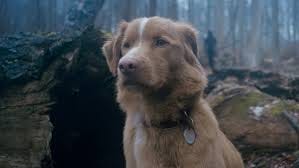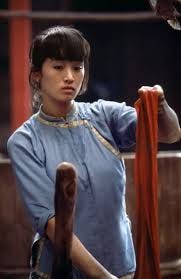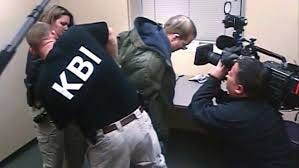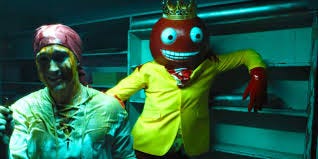Troubles Man
My thoughts on Anemone, Bone Lake, Good Boy, The Ice Tower, Ju Dou, Predators and V/H/S/Halloween
Set in Northern England, Anemone, the debut feature from Ronan Day-Lewis, begins with Jem (Sean Bean) setting off on motorcycle into a remote woodland area in order to drop in on his brother, Ray (Daniel Day-Lewis—yes, Ronan’s father—returning to the screen for the first time since Phantom Thread in 2017), who left long ago to hole up in a cabin for unknown reasons. Although Ray did give Jem the location once, it was with an admonition to only come in case of an absolute emergency, but neither one seems particularly keen on pressing that issue. Over the course of the next few days, the two drink, eat, wander through the woods,and either sit in silence or deliver monologues about their past memories until the reasons behind Jem’s visit can no longer be avoided, which in part revolve around the revelation that when Ray took off, he left behind a wife (Samantha Morton) and a now-grown son (Samuel Bottomley) who, having inherited his father’s propensity for fighting, has now gotten himself into trouble. Having stayed away for so long, Ray must find the strength within to confront the multiple traumas of his past and return for the sake of his long-forsaken family.
As father-son projects go (the two also co-wrote the screenplay), I guess making a film like this is a little more interesting than rehabbing an old car but not by much. The problem is that while the younger Day-Lewis clearly as a keen visual eye that gives the film a striking look throughout that is both lovely and ominous, it falls flat whenever it tries to deal with the characters and their considerable issues. The exchanges between the two brothers and the wife and son back home are pretty creaky and essentially only serve as set-ups for the two extended monologues delivered by Ray—the first has him describing in excruciating gruesome detail the messy revenge he got on a priest who molested him as a boy and the second has him finally recall the actions he took as a soldier during The Troubles that were eventually condemned as war crimes. Alas, the former, while alternately amusing and horrifying, never really connects to anything else going on in the story and the latter kind of falls flat thanks to writing that is both overwrought and underthought (as described, the incident that Ray recounts would not even remotely be considered an actual war crime by anyone). To his credit, Day-Lewis tears in to the material with zeal and his performance, like those of his co-stars, is good (of course, the guy hasn’t given a less-than-impressive performance since the days of such long-forgotten projects as Stars and Bars and Eversmile, New Jersey) but watching him tackle substandard material like this is akin to watching an expert pianist doing scales for a couple of hours. I have no idea if Anemone marks a full-scale return to acting for Day-Lewis or is just a one-off but if it is the former, here is hoping that, having shaken off a decade of accumulated dust here, his future efforts will find him working with material more deserving of his still-considerable talents
.Following an opening sequence that I will get to in a minute, Bone Lake, the new film from Mercedes Bryce Morgan, follows a couple, Diego (Marco Pigossi) and Sage (Maddie Hasson), as they head to a remote Airbnb mansion that they have rented for the weekend. From the start, we get the sense that there are fissures in their relationship (ranging from economics to Diego’s inability to get Sage off) but just as they are settling in, they are interrupted by Will (Alex Roe) and Cin (Andra Nechita), an impossibly hot and flirty couple that has apparently rented the place for that weekend instead. Electing to make the best of an awkward situation,the two couples decide to share the house and as the weekend goes on, the interlopers begin to subtly (and not-so-subtly) provoke Diego and Sage in ways that deliberately seem aimed to crush their relationship once and for all. As it turns out, neither the appearance of Will and Cin nor their erotically-tinged instigations are as accidental as they seem and in the super violent final act, some shocking secrets are revealed, along with a number of internal organs.
If you do go to Bone Lake, be sure to arrive early in order to catch the aforementioned opening sequence, where we see a naked couple running through a forest while being chased by an unknown killer wielding a crossbow and which culminates with the guy getting a arrow fired into his genitalia. The scene is an eye-opener, as it were, but the scene makes promises that it is unwilling to keep, suggesting a hybrid of a slasher movie and an overheated erotic thriller but giving us an increasingly tedious work that plays more like Funny Games at the wrong speed and which forces us to spend more than an hour with four of the least interesting characters to appear on the screen in a while. Morgan’s screenplay is building towards its big, knockout third act twist but this fails as well because the shocking revelation is not nearly as startling (it is tipped with all the grace of a lesser Scooby-Doo episode) or as transgressive as both the film and the characters want us to believe that it is. At least this final section is livened up by a few relatively nasty gore effects but not even the deployment of chainsaws is enough to make Bone Lake anything than a largely tiresome exercise in would-be provocation that never quite works
.In many ways, Good Boy, the debut feature from Ben Leonberg, is a standard-issue supernatural horror film with a story that will seem familiar to anyone who has seen The Amityville Horror, Paranormal Activity and the like. It tells the story of Todd (Shane Jensen), an ordinary guy who, along with his faithful dog Indy (a Retriever played the director’s own dog) impulsive moves into the remote home in the woods that he inherited from his recently deceased grandfather and since the grandfather is played by indie horror staple Larry Fessenden, we can tell instantly that this is not going to go down as a good idea. Sure enough, there are weird noises and apparitions appearing everywhere and Todd starts acting stranger and stranger, occasionally coughing up gouts of blood for good measure. The twist here is that the entire story is related via the point-of-view of Indy, both literally (nearly all of the shots are staged close to the ground) and figuratively and while he may not be exactly sure what is going on with Todd, he instinctively knows that something bad is up and that he will do everything in her power to protect the owner that he truly loves.
Make no mistake about it, Good Boy is essentially a gimmick film but in this particular case, the gimmick in question is one that is relatively ingenious in both concept and execution. Now i am fully aware that what is seen is not so much an acting performance as it is a bunch of shots of a dog doing various things that have been stitched together in a way that creates the impression of a real performance. It is a trick but one that is mostly successful, thanks to the clever ways that Leonberg finds to help viewers share Indy’s perspective, such as keeping us from hearing possibly important conversations so that we have no more information about what is going on than he does, and also due to the fact that Indy makes for a compelling screen presence. I am not much for movies centered around adorable dogs (largely stemming from an childhood incident in which I was compelled to sit through For the Love of Benji in its entirety) but even I found myself completely giving into his largely effective and affecting presence. Like a lot of debut films, Good Boy is occasionally ragged and while it doesn’t quite wear out its welcome despite a relatively brief 72-minute running time, you can begin to feel the strain in the later scenes. (This is another movie that might have been a little more effective as an hour-long episode of a horror anthology series.) That said, it is still, for the most part a reasonably effective spook story for most of its running time and includes the most impressive screen turn from a quadruped in quite some time
.Lucile Hadzihalilovic is a French filmmaker who works are of a decidedly oddball bent (her last film, Earwig, revolved in part around a 10-year-old girl who sported dentures made of ice that required several changes per day) that combine images that are both surreal and ravishing to behold and narrative that can get so opaque at time that responding to them on anything remotely resembling an emotional level is virtually impossible. That is certainly the case with her latest effort, The Ice Tower, which contain any number of beautifully bizarre (or is it bizarrely beautiful?) visuals but not much else. Set in the 1970s, the film stars Clara Pacini as Jeanne, a girl of about 16 who runs away from her foster home in a remote village in France in search of something better. After falling asleep one night in what she believes to be an empty building, she wakes up the next morning to find that it is actually the location where a film is shooting—not only that, it happens to be an adaptation of the fairy tale “The Snow Queen” that she used to read to her foster siblings. Inevitably, she is mistaken for an extra and finds herself part of the production, eventually developing a fascination with Cristina (Marion Cotillard), the somewhat haughty star of the film, possibly because, as she eventually discovers, they share certain similarities in their backgrounds.
There is hardly a single scene in The Ice Tower that doesn’t contain at least one (and oftentimes several) bit of striking imagery. Indeed, from a technical standpoint, the film is often quite spectacular, particularly in regards to the cinematography, production design and costuming, and Hadzihahililovic does do a good job of establishing and maintaining an alternately dreamy and nightmarish atmosphere throughout. The trouble is that these undeniable visual pleasures are in the service of a story that is not nearly as complex or enigmatic as it thinks it is. The relationship between Jeanne and Cristina that forms the eventually heart of the narrative is handled well enough by the two actresses but never really takes hold in any particularly memorable way and the film’s lack of any sense of humor (aside from the droll notion of casting perennial cinematic enfant terrible Gaspar Noe (who is also Haszihahililovic’s real-life partner) as the director of the film-within-a-film) means that the whole thing begins to drag after a while. Still, there is a part of me that almost wants to recommend it despite my obvious misgivings because while it doesn’t “work,” as they say, as a whole, it contains a number of images that will be rattling in my head for quite a while. If The Ice Tower still sounds intriguing to you despite the problems that I have elucidated here, you might want to check it out for yourself and see if you find yourself landing on its extremely particular wavelength
.Now if you want to see a movie that combines a stunning visual style with an equally gripping narrative, you will hardly find one better than Ju Dou, Zhang Yimou’s brilliant melodrama that was suppressed by the Chinese government when it was originally made in 1990 (partly because of its sexual elements, which were fairly explicit by Chinese standards, and partly for its implicit parallels between the story and the political situation of the time), went on to become a critical and commercial success throughout the world and which is now returning to theaters to mark its 35th anniversary. Set in the 1920’s, it tells a lurid and overtly melodramatic story about a monstrous old man who runs a textile factory, the nephew that he hires and treats like a virtual slave and the poor-but-beautiful woman (Gong Li) who marries the former and begins a steamy affair with the latter that eventually leads to tragedy for all. Although the film noir-story is not particularly unique, Yimou certainly tackles it with a lot of gusto and energy and the presence of Gong Li as the woman who comes between the man and his nephew is so striking throughout that it is no wonder that she became an international star after it was originally released. Visually, the film remains a thing of absolute beauty after all these years—the film was processed utilizing the classic three-strip process that Technicolor and the bright colors, especially in the scenes set in the mill, provide a gorgeous contrast to the darkness of the story. If this reissue of Ju Dou ends up playing at the proverbial theater near you, do not hesitate to go and see it—I promise that you will never forget it
.Airing from 2004 to 2007, To Catch a Predator was a Dateline NBC spinoff series in which reporter Chris Hansen, utilizing young-sounding decoys, to lure potential pedophiles to a home where he would grill the mortified suspects about what they were thinking before having them taken away by the cops, all of it captured in lurid detail by a phalanx of camera people. Although the show may have had begun with the noblest of purposes, it nevertheless existed in a moral grey area that went charcoal when one suspect, a Texas district attorney, committed suicide during the sting operation and while the show was cancelled soon after that incident, it has lived on in spirit through the efforts of internet vigilantes aiming to follow in Hansen’s footsteps. In the new documentary Predators, filmmaker David Osit takes a look back at the controversial history of the show, including interviews with people ranging from lawyers who admit that most of the cases against the suspects brought in by the show would not have held up in court to the guy who served as the decoy on the episode that ended in the suicide and who remains somewhat traumatized by the whole thing as well as commentary from ethnographer Mark de Rond, who correctly points out that if Hansen or the police officers were seen showing any sort of empathy towards the suspects (as they do in raw footage that was not aired), the entire concept behind the show would completely collapse. Osit also tackles the show’s equally troubling and enduring cultural afterlife through a look at one of its more popular online copycats (run by someone who seems more interested in deploying their catchphrase, “You’ve just been skeeted,” than anything else and is at a loss when his obnoxious approach backfires in a potentially tragic manner) and with an interview with Hansen himself, who has gone on to create a mini-empire for himself based on the conceit of enacting justice outside of the necessary constraints of the criminal justice system. Predators raises a number of questions about the show, the issues that it inadvertently raised and whether even people like those caught in Hansen’s snare really deserved to be publicly humiliated in the name of entertainment and while it doesn’t necessarily answer them all, it gives viewers plenty to think about regarding To Catch a Predator and its deeply troubling legacy
.Since the last few Octobers have each seen a new installment of the V/H/S/ franchise, a series of horror anthology films each consisting of several gruesome tales of found-footage fright, each one from a different indie filmmaker and based around a common theme or setting, it was probably only a matter of time before the producers would get around to officially making a V/H/S/Halloween. This time around, the stories kick off with Anna Zlokovic’s “Coochie Coochie Coo,” in which a couple of co-eds dress up as babies and visit a haunted house inhabited by an entity known as The Mommy—needless to say, it doesn’t go well. Paco Plaza’s “Ut Supra Sic Infra” follows the lone survivor of a Halloween celebration that went very bad who is forced by police to return to the scene of the crime and discovers that the horror isn’t entirely in the past. Casper Kelly’s “Fun-Size” focuses on a group of college kids who, while trick-or-treating, violate the “one per person” sign at one house and wind up in a candy factor malevolent enough to give Mr. Wonka the willies. Alex Ross Perry’s “Kidprint” is a grim and ghastly thing about a videographer who offers to help make video recordings of the kids in a town plagued by child abductions and murders, only to suspect that a member of his staff may be connected to the crimes. Micheline Pitt-Norman and R.H. Norman’s “Home Haunt” finds a father who decides to reopen a local haunted maze as a bonding activity with his son, only to inadvertently arouse any number of evil spirits once he adds an old LP of spooky sounds to the mix. Serving as a connective tissue to the five stories is Bryan M. Ferguson’s “Diet Phantasms,” in which we see the research tests for a brand-new diet soda and the gruesome effects that it has on the unsuspecting people brought in to give it a try.
As is the case with most films of this type, your mileage may vary in terms of which segments hit and which do not, though this year’s installment as a whole is somewhat of a dip in quality after last year’s impressive V/H/S/Beyond. “Diet Phantasms” has some nice moments of splatstick humor but gets a bit repetitive after a while. “Coochie Coochie Coo” is enlivened by the performances by Samantha Cochran and Natalia Montgomery Fernandez as the two victims but doesn’t quite go anywhere. “Ut Supra Sic Infra” is made with a certain undeniable style but moves a little too slow for its own good. “Fun-Size” strikes a solid balance between the goofy and the gory and would have been the standout segment of the film except for the fact that the protagonists are all singularly obnoxious—believe me, you will not be regretting any of the things that happen to them. “Kidprint,” on the other hand, is genuinely ghastly and brutal (including explicit moments of torture involving children) and while it has definitely been made with a lot of skill, the unrelenting dark tone serves as such a jarring contrast to the goofier stories surrounding it that even the most hardcore gorehound viewers may find themselves put off by it. My personal favorite, though, is the concluding “Home Haunt,” which hits just the right balance of humor and horror and even throws in a cameo by makeup legend Rick Baker for good measure. Although undeniably uneven as a whole, V/H/S/Halloween does have its moments of genuine inspiration and demonstrates that after eight feature films, the basic conceit driving the franchise still has some life left in it, which is more than you can say about the subjects of most of the stories.


